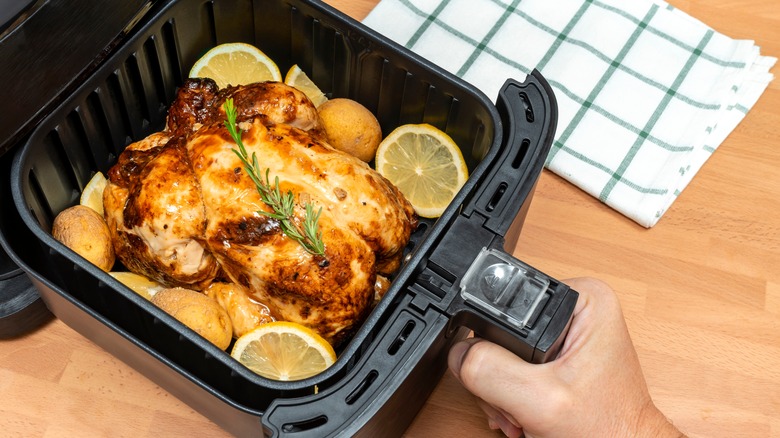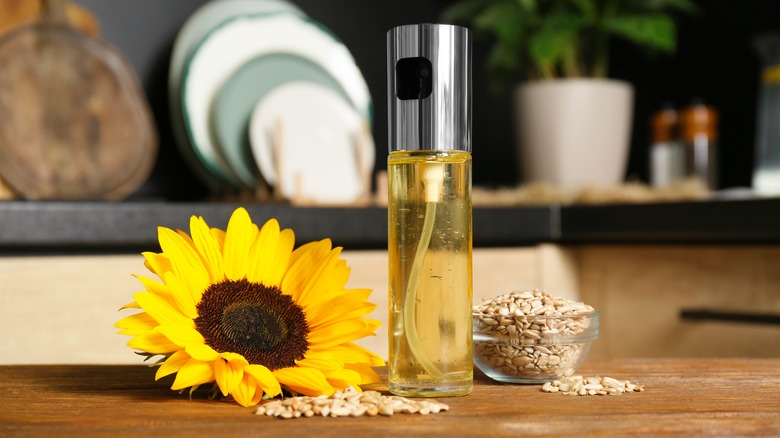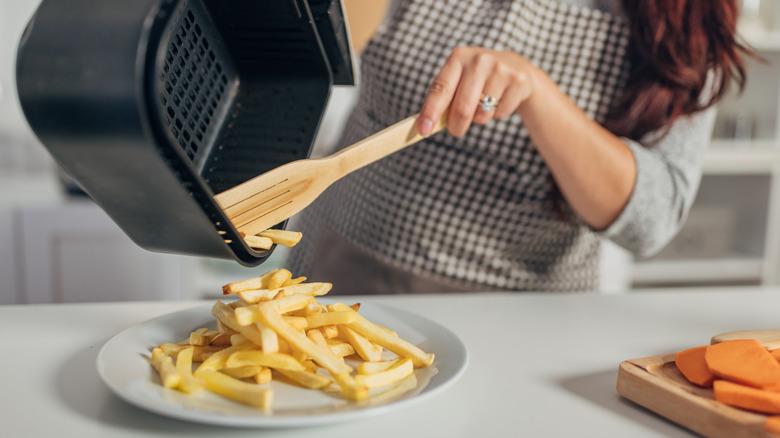The Type Of Cooking Spray That Might Ruin Your Air Fryer
From perfectly crisp French fries to a quick way to cook a chicken breast, the air fryer has become an essential small kitchen appliance. Even though the countertop cooker is basically a small convection oven, the ease of use and quick cooking make it a favorite kitchen item for many home cooks. Since it is a workhorse, users should be cautious before just grabbing any cooking spray to use.
While many people have learned the perils of using cooking spray on non-stick pans, that quick spritz can have lingering impacts on a kitchen appliance's life. Still, the concept of using the right oil for the right cooking temperature applies in an air fryer, just like it does on the stove. Cooking sprays can contain soy lecithin, which has a low smoking point. While no one wants a flame in their air fryer, the low smoke point can cause the lecithin to create a sticky, grimy layer in the appliance. Anyone who has seen a dark, amber-colored film in the basket or tray can appreciate this concept.
As the emulsifier builds up, the non-stick coating deteriorates. While it can be scrubbed, no one wants to use extra elbow grease to scrub those pieces of cooked food off the surface. Overall, the air fryer's efficiency decreases, which is why it is best to think before spritzing that cooking spray.
Is there an alternative to using cooking spray in an air fryer?
While the low smoke point of soy lecithin, silicon, and propellant in cooking sprays can make an air fryer less efficient or ruin the non-stick surface, the small appliance does require some type of oil to keep food from sticking during the cooking process. One solution is to find a pump cooking spray. Since this item eliminates the propellant, it can be beneficial to avoid the dreaded build-up. The non-aerosol option offers ease of use and coverage, just without the unwanted additive.
Another option is to carefully brush the basket with oil. For example, a silicone brush dipped in oil can cover the surface efficiently, or a paper towel works, too. The idea is to lightly cover the surface but not to turn it into an oil slick.
The truth is that an air fryer usually requires some oil. Choosing an oil with a higher smoking point is beneficial. A high smoke point is considered to be 400 degrees or higher. For example, avocado, sunflower, or canola oil are great choices for an air fryer.
While the air fryer might be the quick, efficient way to get dinner on the table, cooks should take a beat when grabbing a cooking spray. A few extra minutes to prep that basket could mean many more uses for your favorite kitchen appliance.
The biggest mistake to avoid when using an air fryer
Since a cooking spray can ruin the air fryer's non-stick surface, one rule can avoid the perilous situation. Instead of spraying the grate, basket, or surface, the food should get the oil spritz. Although the idea of coating food in cooking spray might not have appeal, a touch of avocado or sunflower oil on those tater tots, chicken breasts, or even Brussels sprouts could be the appliance saver. Not only will the food not stick to the surface, but the added ingredient can add color, texture, or even a hint of flavor.
Many air fryer recipes suggest tossing food in oil before cooking. Although no one is suggesting that the ingredients should be swimming in grease, that simple coating helps during the cooking process. From adding to the crispness to keeping in some moisture, an air-fried dish typically needs a little fat to be successful.
Even though the idea of an air fryer meal is meant to be less "fried," for the best results it cannot be devoid of all cooking oil. No one wants a dried, shriveled mess on the plate. Given that the method is a quick-cook, high-heat option, there has to be some type of moisture used in the process. A little toss, brush, or dip in some oil can produce a delectable final product that will get cheers all around the table.


